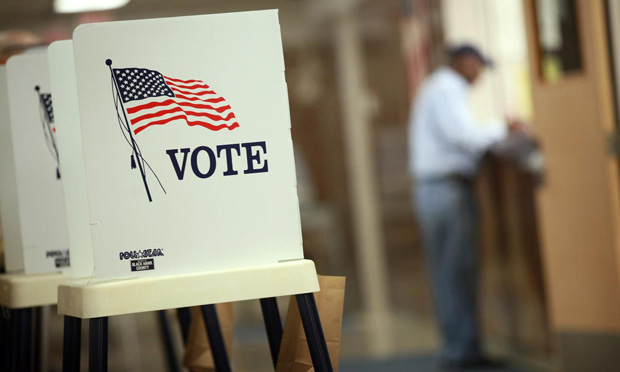
During the last presidential nominating season in 2012, voter turnout fell to record lows in many parts of the United States. About 16 percent of all age-eligible citizens voted in the 2012 presidential primaries, down from about 32 percent in 2008, according to an analysis from the Bipartisan Policy Center. Early primary results in 2016, however, suggested that the year could set new records for high turnouts — at least among Republican voters, who were expected to flock to the polls to decide who, in a volatile race featuring front runners Donald Trump, Ted Cruz and Marco Rubio, would represent the party in the general election.
In Tennessee, state election officials said in February 2016 that they were expecting a “massive” turnout on Super Tuesday, based on higher-than-usual turnout among Republicans during early voting there. In Texas, Republican consultants predicted that the primary would push turnout to the “highest levels in decades.”
A 2009 study from the Harvard Kennedy School, “Voter Participation in Presidential Primaries and Caucuses,” offers important insights about voter turnout and trends. The study’s author, Thomas E. Patterson, reviews data from previous nominating contests to discern patterns of democratic involvement in the modern party system. He examines how 1970s-era party reforms and subsequent shifts in scheduling — particularly the tendency of the parties to “frontload” state primaries and caucuses earlier in the election calendar year — have affected the participation rates of voters in nominating contests.
Key points made in the study include:
- Outcomes in other recent nominating contests were much less promising than those of 2008: “The 1996 nominating races were decided by the lowest overall (Democratic and Republican primaries combined) turnout rate (17.5%) in history, a record that was broken eight years later when a mere 17.2% of eligible voters participated in the primaries. The 2004 election also established a record low for turnout in a contested Democratic race — 11.4%.”
- In 2008, the average state turnout rate for Republicans during the nominating contests was 11.1%, “about the same as the GOP average since 1984, excluding 2004 when turnout was very low because of Bush’s unopposed run for the party’s nomination.” For Democrats, however, the rate was 19%, higher than that for any party contest since 1972. Moreover, “Of the thirty-nine Democratic primaries, twenty-seven set a turnout record for the party.”
- The Iowa caucuses in 2008 saw a record 350,000 people participate. However, “In percentage terms, Iowa’s turnout was hardly earthshaking — only one in six of the eligible adults participated. The Democratic winner, Barack Obama, received the votes of just 4% of Iowa’s eligible voters. Mike Huckabee, the Republican victor, attracted the support of a mere 2% of Iowa adults.”
- Because caucuses require more time from voters, those types of contests have historically seen lower participation rates. This was true of 2008, as well: “Although caucus turnout in 2008 reached record heights, the average caucus attracted fewer than a fourth as many participants as did the average primary election.”
- Though 2008 saw greater inclusion rates for African-Americans and younger voters, historic patterns along the lines of educational attainment were still present: “individuals with a college education were overrepresented among primary voters by a whopping 19.6 percentage points. Moreover, the Republican and Democratic electorates were alike in this respect — the college educated were overrepresented by 18.9 percentage points among Democratic voters and by 20.8 percentage points among Republican voters.”
- “The clustering of state contests early in the schedule is more than just a problem of low turnout in the late contests. It also creates a ‘silent spring’ that affects all Americans, whatever their state of residence. Once the nominations are settled by Super Tuesday, the campaign loses much of its appeal. The conventions are still months away, but the primary races are effectively over, and people lose interest … The cost of frontloading, then, also includes a diminution of election attention, which affects how informed Americans will become about the candidates and issues.”
- Overall voting patterns suggest a historic shift in American civic attitudes: “turnout variation is itself increasing. Sandwiched between the upswings in voting in the 2004 and 2008 presidential elections was a small increase in turnout voting in the 2006 midterm elections and a downturn in voting in the 2005 and 2007 local elections — indeed, turnout in 2007 apparently was the lowest in modern times. Today’s voters appear more selective than those of earlier generations, choosing to vote or not vote based on their sense of an election’s significance rather than out of sense of personal duty.”
Related research: A 2016 paper published in Political Behavior, “National Party Division and Divisive State Primaries in U.S. Presidential Elections, 1948–2012,” explores the relationship between divisive state primaries and general election outcomes. A 2015 study in American Politics Research, “How Presidential Running Mates Influence Turnout: The Risks and Rewards of Revving up the Base,” looks at how the selection of a vice president can affect voter turnout and vote choice. A 2012 study from scholars at Northwestern University and the University of Maryland, “Can Celebrity Endorsements Affect Political Outcomes? Evidence from the 2008 US Democratic Presidential Primary,” assesses the impact that Oprah Winfrey’s endorsement of Barack Obama in 2008 had on Obama’s votes and financial contributions.
Keywords: elections, presidential primary, Iowa, New Hampshire
